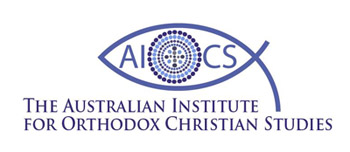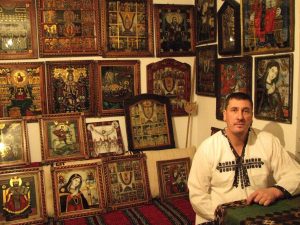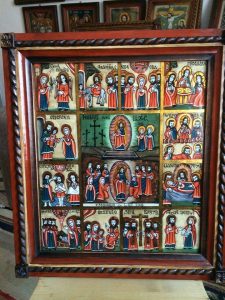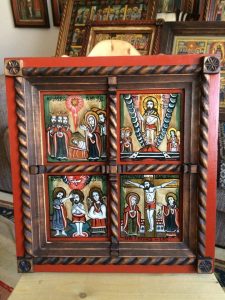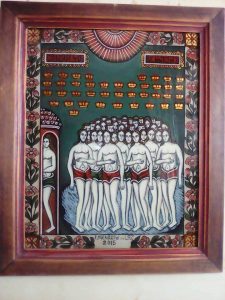An interview with Florin Poenariu, master iconographer
by Alina Victoria Paraschiv
Florin Poenariu and the iconographical treasure of his family
The Transylvanian village of Laz, on the Sebeş Valley, is the centre of a historical school of glass-painted iconography. Throughout the last couple of centuries, most iconographers who worked here were—and still are—members of the Poenariu family. Nowadays, the continuator of this family tradition in the school of Laz is Florin Nicolae Poenariu, who kindly answered several of my questions.
AVP: How have you become an iconographer?
FNP: By trade I am a carpenter and initially I opened a carpentry worksop, here, in Laz. One day, however, my aunt Maria Poenariu ordered from me several frames. When I finished, she invited me to her own workshop, and showed me how to paint icons on glass. I tried and I liked it. In time, painting icons on glass has become a hobby and then a career, which I would not dream to ever abandon.
A festal icon by Florin Poenariu: Christ’s descent to hell and resurrection, and scenes from the Lord’s life. A pattern created by Simion Poenar (1801-1872), glajă (manually made glass), frame painted with şforţ, brănel (plated rope), wooden back, 50/55 cm
AVP: Do you prepare yourself before painting an icon?
FNP: To work on icons, especially when you try to emulate patterns created by your own ancestors, requires meekness and humility. It is a way towards your own perfection, salvation. This demands from you purity of soul.
AVP: What are the stages of making a glass-painted icon?
FNP: First you need to choose the glass and degrease it, after which you draw the contours. When the contours are drawn, you apply the colours and, when the paint gets dry, you apply golden leaf. Then you frame the icon. I use glajă (manually made glass, through the process of “blowing”) and genuine golden leaf. My frames have wooden back and I apply brănel (the motif of plated rope) on the margins, as it was done a hundred and fifty or two hundred years ago. Since I am a carpenter, I make my own frames.
A festal icon by Florin Poenariu: Christ’s Birth, Baptism, Crucifixion and Resurrection; glajă, frame with şforţ, brănel, and wooden back, 40/42cm
AVP: The iconographical school of Laz has continued through the generations, by and large its history being linked to your family…
FNP: The school of Laz has its own style. While each painter left his or her mark, there is continuity within the tradition. Many of my ancestors, indeed, were master iconographers, from Savu Poenar (1777-1829), Simion Poenar (1801-1872), Toma Poenar (1835-1874), Ioan Poenar (1837-1898), Ilie Poenaru (1870-1917), Aron Poenariu (1862-1921), Partenie Poenariu (1871-1921), Ilie Poenariu (1883-1977), Maria Poenariu (1923-2015), down to the present day. I have not included in this list their respective disciples. From my viewpoint, Simion Poenar was by far the most talented of my ancestors.
An icon by Florin Poenariu: The Holy Forty Martyrs, pattern created by Simion Poenar (1801-1872)
AVP: Obviously, this family tradition is not lost…
FNP: I try to continue the art of my ancestors with great reverence and admiration. They were the trailblazers, leaving to us such a precious heritage.
AVP: Do you intend to hand this art down to a disciple, perhaps your own children?
FNP: Of course, I would very much like to see my children, Mara and Savu, continuing this God-given gift. Mind you, Savu bears the name of his first-known ancestor, Savu Poenar, who established the beautiful tradition of glass-painted iconography in Laz, on the Sebeş Valley.
You can contact Florin Poenariu via his Facebook profile and his page Icoanele Poenarilor din Laz, where you can admire his art and the icons of the school of Laz.
[Trans. from Romanian and adapt. by Doru Costache]
8 April 2020 © AIOCS
